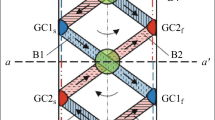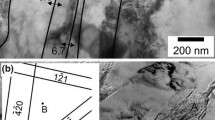Abstract
The development of Chernov–Luders bands on elastoplastic transition in low-carbon steel is investigated. The main factors responsible for the creation and development of the bands are identified. The kinetics of the mobile band boundaries (fronts) is of particular interest. The characteristic speeds are determined. The nucleation rate of Chernov–Luders bands exceeds their expansion rate by more than an order of magnitude. The simultaneous development of more than one band, with the appearance of several moving fronts, is considered. In all cases, the fronts of the Chernov–Luders bands move at matched speeds, so that, at any time, the generalized expansion rate of the deformation zone is constant. The influence of the strain rate on the kinetics of the band fronts is analyzed. Both the generalized expansion rate of the deformed zone and the speeds of individual fronts increase with increase in the loading rate. This is a nonlinear dependence (a power law). The fronts of the Chernov–Luders bands are complex in structure. Different sections of the front may move at nonuniform speeds, so that the front is locally distorted and split. Ahead of the front, in the undeformed sample, precursors whose configuration resembles that of the incipient Chernov–Luders bands may be observed. When they meet, the fronts of adjacent bands cancel out. Annihilation of the band fronts is a complex process, characterized by the formation of precursors and secondary diffuse Chernov–Luders bands. These findings indicate that the simplified concept of the Chernov–Luders bands as a deformed region in a loaded sample, as the front of a band, or as the boundary between deformed and undeformed zones must be revised. A microscopic theory of Luders deformation is based on the cascade growth in density of mobile dislocations on account of their breakaway from the points of attachment and their subsequent multiplication, which occurs instantaneously at the upper yield point within the crystallite (grain). At the same time, the formation of a mobile macroscopic strain front calls for the transfer of plastic deformation by adjacent grains, without strengthening. In other words, grain-boundary accommodation is required. The results obtained suggest that the Chernov–Luders band is such an accommodation zone, and so it has a complex structure.
Similar content being viewed by others
References
Pelleg, J., Mechanical Properties of Materials, New York: Springer, 2013.
Physical Metallurgy, Cahn, R.W. and Haasen, P., Eds., Amsterdam: North-Holland, 1983, vol. 3.
Honeycombe, R.W.K., The Plastic Deformation of Metals, New York: Edward Arnold, 1968.
Chrysochoos, A. and Louche, H., An infrared image processing to analyses the calorific effects accompanying strain localization, Int. J. Eng. Sci., 2000, vol. 38, no. 16, pp. 1759–1788.
Sun, H.B., Yoshida, F., Ohmori, M., and Ma, X., Effect of strain rate on Lüders band propagating velocity and Lüders strain for annealed mild steel under uniaxial tension, Mater. Lett., 2003, vol. 57, no. 29, pp. 4535–4539.
Avril, S., Pierron, F., Sutton, M. A., and Yan, J., Identification of elasto-visco-plastic parameters and characterization of Lüders behavior using digital image correlation and the virtual field method, Mech. Mater., 2008, vol. 40, no. 9, pp. 729–742.
Plekhov, O.A., Naimark, O.B., Saintier, N., and Palin- Luc, T., Elastic-plastic transition in iron: structural and thermodynamic features, Tech. Phys., 2009, vol. 54, no. 8, pp. 1141–1146.
Cottrell, A.H., Dislocations and Plastic Flow in Crystals Oxford: Oxford Univ. Press, 1953.
Conrad, H., Effect of stress on the Lüders band velocity in low carbon steels, J. Mech. Phys. Solids, 1963, vol. 11, pp. 437–440.
Johnston, W.G. and Gilman, J.J., Dislocation velocities, dislocation densities, and plastic flow in lithium fluoride crystals, J. Appl. Phys., 1959, vol. 30, pp. 129–134.
Dudarev, E.F., Mikroplasticheskaya deformatsiya i predel tekuchesti polikristallov (Microplastic Deformation and Yield Stress of Polycristals), Tomsk: Tomsk. Gos. Univ., 1988.
Zuev, L.B., Gorbatenko, V.V., and Pavlichev, K.V., Elaboration of speckle photography techniques for plastic flow analyses, Meas. Sci. Technol., 2010, vol. 21, no. 5, pp. 054014–054019.
Jones, R. and Wykes, C., Holographic and Speckle Interferometry, Cambridge: Cambridge Univ. Press, 1983.
Cottrell, A.H. and Bilby, B.A., Dislocation theory of yielding and strain ageing in iron, Proc. Phys. Soc. London, A, 1949, vol. 62, pp. 49–62.
Gorbatenko, V.V., Danilov, V.I., and Zuev, L.B., Elastoplastic transition in material with sharp yield point, AIP Conf. Proc., 2015, vol. 1683, p. 020058.
Gorbatenko, V.V., Danilov, V.I., and Zuev, L.B., Plastic flow instability: Chernov–Lüders bands and the Portevin–Le Chatelier effect, Tech. Phys., 2017, vol. 62, no. 3, pp. 395–400.
Hahn, G.T., A model for yielding with special reference to the yield-point phenomena of iron and related bcc metals, Acta Metall., 1962, vol. 10, pp. 727–738.
Žerovnik, A., Pepel, V., Prebil, I., and Kunc, R., The yield-point phenomenon and cyclic plasticity of the uniaxially loaded specimens, Mater. Des., 2016, vol. 92, pp. 971–977.
Beardsmore, D.W., Quinta da Fonseca, J., Romero, J., English, C.A., Ortner, S.R., Sharples, J., Sherry, A.H., and Wilkes, M.A., Study of Lüders phenomena in reactor pressure vessel steels, Mater. Sci. Eng., A, 2013, vol. 588, pp. 151–166.
Armstrong, R.W. and Zerilli, F.J., Dislocation mechanisms aspects of plastic instability and shear banding, Mech. Mater., 1994, vol. 17, no. 1, pp. 319–327.
Author information
Authors and Affiliations
Corresponding author
Additional information
Original Russian Text © V.I. Danilov, V.V. Gorbatenko, L.B. Zuev, D.V. Orlova, L.V. Danilova, 2017, published in Izvestiya Vysshikh Uchebnykh Zavedenii, Chernaya Metallurgiya, 2017, No. 10, pp. 831–838.
About this article
Cite this article
Danilov, V.I., Gorbatenko, V.V., Zuev, L.B. et al. Luders deformation of low-carbon steel. Steel Transl. 47, 662–668 (2017). https://doi.org/10.3103/S0967091217100035
Received:
Published:
Issue Date:
DOI: https://doi.org/10.3103/S0967091217100035




